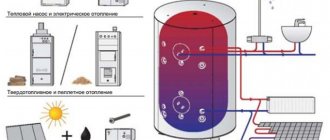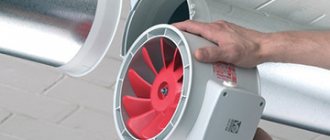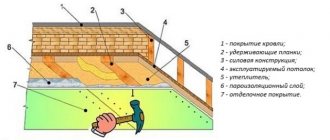Heating a garage: the most economical and cheapest way
Heating a garage depends on the capabilities and desires of its owner.
First of all, the time people spend indoors in the autumn-winter period is taken into account. Of course, the cost of heaters plays an important role. Before you begin installing a heating system, you need to choose the most economical way to heat your garage. Electric heating of garages can be considered the most popular and economical way. Moreover, this method is suitable in cases where the garage is located a certain distance from a residential building and has small dimensions.
There are a number of methods for heating a garage in winter using electric convectors. An electric convector is a safe and highly efficient electrical device that works on the principle of heating cold air entering it from the room, and rising when heated.
This design, of course, is very convenient, because it makes it possible to place the heating device both on the wall and near the car during its repair. Despite some disadvantages that convectors have, for example, the effect is achieved 30 minutes after connecting it, the consumption of electrical energy increases, and the high price, yet electric convectors also have a lot of advantages:
- heat rooms automatically and manually;
- safe and simple operation;
- durable;
- work in damp and dusty rooms, as they are protected by the housing.
Electric convectors come in floor-mounted, wall-mounted and universal versions, that is, with support legs and a mounting bracket for attaching the equipment to the wall. But this is not the most economical way to heat a garage with electricity.
A fan heater is a device that works on the principle of heating a heat exchanger (heating element or coil) using electrical energy: air masses from the room enter the heating elements and are returned warm to the room. When the fan heaters operate, there are no emissions into the environment, the switch for heating mode and fan rotation allows you to adjust the heating strength, their small size and compactness allow you to install them in any convenient place in the garage.
Focused heating of any zones and objects occurs, as well as rapid heating of rooms, such equipment can automatically turn off when overheated or tipped over, equipped with an additional electric regulator allows you to maintain the set temperature in the garage, these devices are easy to use and have a relatively low price.
The presence of some disadvantages, such as a decrease in humidity in the room during heating, the accumulation of dust in the heating element, which can lead to a fire, its noisy operation, and an increase in electrical energy consumption, however, does not prevent fan heaters from being very in demand and popular for heating garages.
Advantages of heating from electricity
If you decide to heat your garage with electricity, you should definitely consider the most economical method. The use of electricity allows you to get many advantages, namely durability and high efficiency, ease of use, ease of installation of devices, and no need for maintenance. It should be noted that the use of electricity is safe; the devices will operate silently and will not emit dust. Each of them can be easily replaced, as well as the components of the equipment. The garage owner will not have to obtain permits to install the system.
If you are interested in heating your garage with electricity, the most economical method will probably also interest you. One of the main disadvantages of this approach is the high cost of electricity. But you can organize heating with electricity if you install a thermostat that will turn off the system at the moment when the air temperature reaches a certain point.
Ways to heat a garage in winter
How to heat a garage in winter? Depending on where the garage is located, there are two ways to heat it:
- Connect the building to the home heating system: this is the most convenient option, but it is only available if the garage is attached to the house or is located just a few meters from it. Before implementing such a project, you will need to make sure that the power of the boiler and circulation pump is sufficient to connect one more consumer.
- Installing your own room heating system: this option remains for those who have a garage located at a considerable distance from the house. In what follows, we will consider just such a situation.
It should be noted that the commissioning of heating equipment must be preceded by work on insulating the garage, otherwise even the most economical heating will be too expensive. It is better to insulate a brick building from the outside (except for the gate) - then the walls will last longer. It is better to insulate a metal box, if it is spacious enough, from the inside: then you will not have to worry about protecting the heat insulator from the weather.
Thermal insulation materials are produced today in a variety of ways, but mineral wool and polystyrene foam retain heat best. Polystyrene foam is convenient because if it gets wet, it remains fully functional. But on the other hand, it is a flammable material (when burned, it produces very toxic smoke) and for some reason is very popular with mice and other rodents.
Mineral wool does not burn and no one eats it, but this material must be protected from water - when wet, it almost completely loses its thermal resistance.
The most affordable way to insulate a roof is to backfill a 15-20 cm layer of expanded clay on top of a slab. A cement screed is laid on top, then a waterproofing coating. If you are willing to overpay a little, but get more effective insulation, pay attention to basalt wool slabs designed for insulating flat roofs. Unlike ordinary wool, they are rigid and can withstand loads of up to 80 kPa (about 8000 kg/sq. m).
The garage owner should pay attention to the modern type of mineral wool - basalt or stone wool. Thanks to oil treatment, it is more water resistant than other varieties.
Is it possible to call heating using diesel fuel and waste fuel economical?
If you receive them completely free, then you can heat a room of any size, including a garage, simply and without investing large amounts of money. This economical heating will best achieve the required temperature in the shortest possible time and will be able to heat the room for a long time.
It is extremely rare to use diesel fuel to heat a garage, since it is not entirely practical
It is not uncommon for people to have access to materials such as:
In order to use such fuel, you can use self-created units, but only if they have an inlet for removing combustion products outside. The structure must be connected in accordance with fire safety requirements to reduce the likelihood of fire to a minimum.
A garage heated in this way will be very comfortable and pleasant to stay in, and the original boilers should be positioned so that metal or asbestos sheets are placed around them.
It is advisable, to maintain safety, to use exactly those boilers that are already ready for operation and only require a connection, since they meet all the necessary standards and eliminate the possibility that the heater will cause a fire or more serious consequences.
The heating design must have a special container for oil, which can be made from a gas cylinder or other products of a similar type. The length of the exhaust of combustion products into the chimney must be at least 1 m and have a diameter of 15 cm. It is best to install straight chimneys to increase the level of heat transfer. Oil is poured into the tank 3/4 full, and ignition is carried out using a blower. As a rule, the oil does not burn completely and no smoke is produced. The oil must be free of impurities and water. This heating can be water and such heaters operate on antifreeze.
Do-it-yourself garage heating: electricity
Electric heating today is quite expensive. But the garage does not require much heat - it is enough to maintain the temperature at +5 degrees, so with good insulation, an electric heater will not hurt your pocket. Such devices can be divided into two groups: those that transfer heat to the internal air through contact and infrared ones.
Heaters that transfer heat to the surrounding air through direct contact
Traditional representatives are oil and quartz heaters.
The disadvantage of these devices is that their surface, for safety reasons, cannot be heated to a high temperature, so they do not have high performance. A more efficient device is a convector.
Its body is, in fact, a vertically installed rectangular pipe, inside of which a heating element is placed.
The housing does not come into contact with the heating element, so it does not heat up much and you cannot get burned on it. But the heating element heats up to a temperature of 600 degrees, as a result of which a powerful stream of hot air blows from the convector, like from a fan.
You can quickly warm up your garage using a fan heater - it distributes warm air not by convection, but by force.
Thermal (infrared) emitters
The devices described above allow you to create an even microclimate throughout the garage, but if it is not insulated or constantly ventilated (for example, there is a welding station with powerful ventilation inside), they will be of little use.
In such a situation, the right solution would be to install an IR heater.
The spiral in it heats up to a red glow, as a result of which it becomes a source of powerful thermal radiation.
Thus, the device transfers heat not through the air, but directly to the user and other objects, so even in an open area with such a heater it will be warm.
IR radiation is not harmful - solar heat is of the same nature.
Are you here
With the onset of winter cold, more and more car owners are thinking about what and how to heat their garage inexpensively. They are not bothered by the fact that most modern cars, including those running on diesel fuel, start quite reliably even at -10...15 degrees below zero.
The Russian folk tradition - which we will probably not get rid of very, very soon - is to repair your car yourself in your own garage. And even if nothing is broken, spending a weekend in the garage is akin to time spent fishing – it doesn’t count against your life.
How to heat a garage in winter without electricity
What should those who have not yet reached the benefits of civilization in the form of electricity do, how to heat the garage in winter if there is no electricity? Which is better to choose? These lucky ones can be offered several options.
Gas heaters
Among all non-electric heating devices, these are the most convenient to use. Gas enters the burner without user intervention or any additional devices, since it is stored in the cylinder under high pressure.
Other advantages are complete combustion of fuel (no ash) and relatively clean exhaust, consisting mostly of water and carbon dioxide.
Heating a garage with a gas heater
Today, manufacturers offer potential buyers two types of gas heaters:
Traditional
They work in the usual way: a flame burns in the burner, which heats the surrounding air and the body of the device. The latter plays the role of an infrared (thermal) emitter. Combustion products contain carbon monoxide, so such a heater must be equipped with a chimney.
Heating a garage with gas will cost much less than other heating methods. What should a gas heater be for a garage? See an overview of the models, their advantages and disadvantages.
Read on to learn how to install a hood over a gas stove.
Although the garage is a non-residential space, it requires ventilation. Here https://microklimat.pro/sistemy-ventilyacii/kak-sdelat-vytyazhku-v-garazhe.html information on how to install a hood in the garage.
Catalytic
New generation of gas heaters. In these devices, gas oxidation is carried out due to the chemical activity of the catalyst, so there is no flame in them. The reaction of gas fuel with oxygen occurs on a so-called catalytic panel made of fiberglass. The best catalyst is platinum, but today they are trying to use other materials.
Theoretically, the fuel in a catalytic heater burns completely, meaning no carbon monoxide is produced. Therefore, such a device does not need a chimney.
However, as practice has shown, much depends on the integrity of the manufacturer. For example, owners of Turkish heaters report that soon after turning on the device it becomes impossible to breathe in the room. A high-quality device can also create discomfort.
The point is the fragrance that is added to the gas in order to detect its leakage. One way or another, experienced users strongly recommend ventilating the room in which such a device operates.
Gas guns
Such a device will be indispensable if the room needs to be heated very quickly. There are models that do not require a chimney, and those equipped with one.
The gun owner should first of all learn the safety rules:
- when determining a place for the device, remember that the flow of warm air can knock over light objects;
- do not point the heater nozzle towards flammable or explosive substances;
- To ensure that gas leaks can be detected promptly, store cylinders with this fuel as high as possible (the gas is heavier than air).
It is better to spend a little more money and purchase a model equipped with a gas analyzer sensor. As soon as it detects a decrease in oxygen concentration below the permissible level or the presence of carbon monoxide, the device will immediately turn off.
Solid fuel heaters
The advantage of units of this type is that the fuel for them is literally under your feet - in any area you can prepare at least a small supply of firewood for free. But, unfortunately, such heat generators cannot operate for a long time without user participation.
If you are not too lazy to often run to the woodpile, pay attention to one of the following varieties:
- stoves with top combustion (for example, Stropuva brand);
- gas generator or pyrolysis furnaces;
- ovens with forced air supply (can be turned off and on automatically).
All these varieties are called long-burning stoves, since they can work on one portion of fuel much longer than a regular potbelly stove.
However, it should be noted that they all require power supply.
You can also install a pellet stove: it has a hopper into which you can load a large supply of fuel (pellet granules) and a screw feeder, through which it is supplied in small portions to the burner.
Solid fuel boiler
How else can you heat your garage in winter? There is no need to give up traditional solid fuel. Firewood, coal, pellets, and even manure, if you have enough of it - all this can go into the firebox. You can build a simple oven in the garage with your own hands. By the way, it is the potbelly stoves that have not yet given up their position in the fight against the cold in garage towns. Newfangled electrical systems are still far from popular.
A simple stove can be lined with bricks or stones, this will increase the heat transfer area
Long-burning wood-fired boilers for the home. Principle of operation, scope of application, main manufacturers, selection criteria, how to make it yourself, installation features, recommendations of specialists - read in the publication.
Such a heating device requires constant supervision, but for temporary heating it is suitable like no other. You'll stay warm even if your garage's electricity is cut off for non-payment.
Modern manufacturers offer a wide range of small solid fuel boilers that can be used for car bunkers. They are economical, easy to use and compact.
Water heating
In a block of several garages, you can install a water heating circuit with radiators, and install a heat generator with a circulation pump in one of them or in a specially built extension.
The boiler can be gas or solid fuel.
Note that for a small number of garages it is unwise to use water as a coolant.
It is much easier to install a convector stove and connect to it an air duct system through which hot air will be supplied to the garages.
Of course, it is much inferior to water in heat capacity - it is 800 times lower, but it will be quite enough to deliver heat over a short distance. At the same time, the heating system is significantly simplified and cheaper, and you can simply forget about such phenomena as leaks, freezing or boiling of the coolant.
Heating a garage is necessary, and everyone is trying to do it as economically as possible. Do-it-yourself garage oven: types of structures and their manufacture.
Damp, stagnant air is poorly tolerated not only by people, but also by cars, so to keep your car safe, you need high-quality ventilation in the garage. In this topic, we will consider the device diagram and ventilation installation rules.
Installation of a solid fuel boiler with air heating
Installation of a solid fuel boiler with air heating (without connecting the liquid circuit) is carried out as follows:
- Preparing the place where it will be installed. The walls and floor nearby (at a distance of at least 50 cm inclusive) are finished with non-combustible material. The ideal option is to install a box made of refractory bricks.
- Chimney installation. It is better to “cut” the hole for the pipe using a powerful hammer drill and a diamond bit for stone. Such transitions in chimneys must be avoided. Over time, the seams can burn out, which will lead to smoke in the room.
- Boiler installation. Recommended performance is about 10 kW. If a pyrolysis boiler is installed, then the chimney should be additionally insulated (otherwise soot will regularly accumulate in it). The boiler and the chimney outlet can be connected with a corrugated metal pipe.
- Fixing the boiler (using dowels on the plates on the bottom). A mandatory item that many people ignore. Fixation allows you to avoid distortions and depressurization with the chimney. It is imperative to check that the boiler is level using a building level.
- Test warm-up (one fuel load). At the same time, the tightness of the connection with the chimneys and the absence of reverse draft are checked.
A solid fuel boiler can also be placed outside the garage in an extension; according to many criteria, this is more convenient. But in the garage itself, it is necessary to run a heating circuit or at least a radiator, heated by the boiler. The efficiency of such a system is much lower; part of the heat will be dissipated into the environment rather than entering the room.
The best way to heat a garage in winter
If it is not possible to install expensive heating systems, you can make do with homemade heating options. From today's article you will learn how to make a gas heater for a garage with your own hands, and also understand electric and diesel installations for heating the room. Before starting work, you need to decide whether the heating will maintain a stable temperature or just warm the building only for the time that people are there. On the one hand, round-the-clock heating will extend the life of your iron horse and building, but on the other hand, intermittent heating is much more economical.
Permanent heating system
The best way to heat a garage is to connect it to a common circuit. This option makes sense if the garage is attached or is part of a building with common heating. In other cases, you need to make a separate heating and ventilation system.
When the task is to heat the room for a long time, it is better to choose gas and electric boilers. The gas heater is practical and easy to use, the fuel is available and inexpensive. But there is one caveat - you need to allocate space for the boiler room and connect to the gas main. Electric boilers are much safer, but such a heat source cannot be called cheap. It is for these reasons that motorhomes are less and less frequently drowned today.
You also need to remember about wood heating. At the moment, solid fuel is the most economical type. There are different options for such systems: pyrolysis combustion, home-made heaters, or all kinds of potbelly stoves and fireplaces. On sale you can find fully automated pellet boilers with fuel supply without human intervention.
It is difficult to choose which of the permanent heating systems will be more economical - when calculating, you need to take into account not only the price of purchasing and installing the equipment, but also think in advance how much the operation and raw materials will cost. It must be said that different heating systems are suitable for each region of our vast homeland. In places with an abundance of wood, the choice will fall on solid fuel units. In gasified areas, gas boilers and heat guns are most used.
If you don't spend much time in your garage, an electric heater might be the way to go. It does not require special installation skills. Even if such devices are resource-intensive, for heating for a short time this will be the best choice.
Boiler or convector: which is better?
Specialists who install heating systems in garages divide them into several types. It is possible to develop this type of heating with your own hands if you know the features of the technology and follow the instructions.
It is worth considering such methods of heating a garage as:
- Water heating using an electric boiler.
- Heating using an electric convector.
The first option involves the use of an electrical circuit in which pipes are used to transport the energy carrier
Radiators can also be used to transfer thermal energy, the necessary mechanisms and devices, namely a circulation pump, an expansion tank, and shut-off valves. It is important to correctly draw up a garage heating scheme, taking into account all the design features.
The second option involves installing convectors indoors. All the benefits are obvious - you will no longer need to make heating circuits, and also resort to the services of specialists to install high-quality and reliable equipment.
Intermittent heating
Most garage buildings are unheated, but in order to carry out repair work in the cold season, you need to create a comfortable temperature. Of course, it is much easier to buy a heater in a construction hypermarket, but it is much more interesting to build a heating system yourself.
Today, drivers use a wide variety of devices for heating: gas burners, electric and infrared heaters, heat guns, potbelly stoves, solid or diesel fuel boilers. You can do all this with your own hands. Each option has positive and negative sides, let’s look at them in more detail:
-electric heaters . The main advantage is ease of use. There is also an advantage in heating efficiency. The negative side is the rather large bill for consumed electricity after use;
-gas-burners . Plus - a cheap type of heating. Disadvantage - during operation, decomposition products are released, which, if accumulated, are dangerous;
-solid fuel and diesel stoves . Such boilers, although they are the most economical heating option, also have disadvantages. They constantly need to be refueled; they cannot operate completely autonomously. In addition, the price of diesel is high;
- used oil devices . Undoubtedly, they heat superbly, but too much soot appears from their operation and, most importantly, they are a dangerous type of heating.
Heating with solid fuel
A widely used garage heating option. Solid fuel boilers are completely autonomous and at the same time economical. The following can be used as fuel:
- Used oil (waste oil). It's cheap and requires little fuel. But they are fire hazardous; during operation they emit huge volumes of carbon monoxide.
- Coal. Cheap and cheerful, but quite dirty.
- Firewood. The cheapest fuel.
The fuel is burned in a compatible boiler. The most economical is pyrolysis. One load of fuel in it is enough for 8 – 12 hours of active heating. In combination with a liquid circuit with coolant, this heating method will allow you to heat the garage from the inside to a comfortable temperature of 15 - 18 degrees and maintain it for 5 - 10 hours.
Modern pyrolysis boilers support the connection of an automatic air supply regulator. This way you can tune their performance
Or you can simply install a “potbelly stove” and heat the garage with it. This will be the best option if its area does not exceed 20 - 30 m². But you will additionally need to install a chimney and a ventilation system (at least with natural air flow).
Infrared installations
The use of infrared heating systems requires wiring. The heaters use a minimum of energy and are suitable for heating the garage, even if there are drafts in it.
Such heaters differ from others in their heating safety. They propagate waves similar in properties to solar radiation. This type of heating does not heat the air, but nearby objects.
Heated objects release the resulting temperature to the environment. Thanks to this, the air does not dry out. Infrared lamps are very popular in everyday life. They are purchased not only for heating warehouses and garages, but also residential buildings.
Of course, the price of infrared heaters is higher than that of gas or diesel appliances. However, the high cost quickly pays off due to a long service life.
Pros of this heater:
-long service life;
-low cost of resources;
- warming up the room in the shortest possible time.
Infrared installations are most often installed in the ceiling area, so the heat flow goes towards the floor. Thanks to this installation, they take up minimal space.
The disadvantages of this type of heating are that the device heats the body of the iron horse, which can cause corrosion or deformation of the body. It is also not recommended to use the device in rooms with high humidity. In addition, it is strictly forbidden to place it near flammable substances.
DIY infrared burner
We will need an old heater, it will need to be rebuilt. We make the heat reflector from aluminum foil and attach it directly to the back wall of our device. The heat, reflected from the screen, will be distributed throughout the room.
Mix graphite powder and epoxy. We apply the resulting mass onto previously prepared sheets of laminated plastic in wavy strips so that when the sheets are joined, our solution comes into contact with each other. Then we connect the electrical wires from opposite edges to pre-prepared terminals. The heating power is controlled using a thermostat. The heater is ready.
Operating principle and design
Heating devices of the described type consist of a metal body into which tubular heating elements are built. They are controlled by a thermostat. Each of the heating elements is a high resistance conductor, which is placed in a ceramic shell. The conductor housing is sealed and made of steel or aluminum. This design allows you to significantly increase the area of interaction with air, providing heating. The temperature of the element can vary from 60 to 100 degrees. Before heating your garage, you should familiarize yourself with the operating principle of the convector. After switching on, the heating elements begin to warm up. According to physical laws, air whose temperature decreases begins to fall down. It enters the structure through the lower grille and passes through the heating elements. This allows for constant air movement. The process of repeated air circulation allows you to create a comfortable microclimate in the garage. If necessary, you can use fans, with the help of which natural convection will be accelerated. If you are thinking about how to heat a garage, you should remember that convectors, due to their design features, have one main drawback, which is expressed in uneven heating of the air. Thus, the temperature at the floor surface remains lower compared to that at the ceiling. However, it is worth noting that this disadvantage is characteristic of water heating. Another additional disadvantage is the rise of dust, which occurs during the circulation of flows. In order to eliminate this drawback as much as possible, you should choose more modern convectors that do not have these features.
Gas heaters
-fast heating of the building;
-gas cylinders are inexpensive and also widely available.
Mobile heaters are convenient not only because they can be placed anywhere, but also because they can be taken to another place.
Increasingly, gas burners are being chosen for intermittent heating because these devices are small-sized and economical. According to their design, such heaters are divided into 2 types:
- open-type combustion chamber - they are equipped with safety valves and air analyzers that block gas leakage;
-closed camera - such devices are safer and more reliable because they prevent harmful substances from entering the room.
To operate gas furnaces, you will need a separate boiler room at a regulated distance from the garage, since the presence of gas equipment in the same room as the machine is prohibited! You also need special permission from the relevant services.
If the goal is to warm up the motorhome from time to time, you can use gas cylinders. Calculate the volume of gas required based on the expected mode of use and the power of the operating unit. Cylinders should be kept in a metal cabinet, preferably insulated, located above the floor level.
Gas units come in several types:
As for the latter, their work process occurs without a flame - a chemical reaction, which results in the oxidation of gas with oxygen, generates heat. The catalyst here is platinum or other elements of a similar group. These heaters are lightweight and easy to operate, but there is one drawback - they are quite dangerous to handle.
A few words about the convector - it burns a gas-air mixture in a tank, which is separated from the room by sealed walls. A prerequisite is to prevent drafts. Often, oxygen is taken from the outside of the garage, and combustion products are also released there, so you don’t have to worry about carbon monoxide poisoning.
Infrared burners heat not the air, but nearby objects. This warming method is also very effective and affordable for garage space.
Heating a garage with a heat gun is the most effective way to heat the air. The device will instantly raise the temperature to the required value. Often, a gas gun is used in large garage complexes and service stations. The principle of operation is the combustion of gas and the operation of a fan, resulting in warm air blowing.
When choosing a gas gun, you should consider the following nuances:
-how much time people spend in a heated room;
-what is the level of thermal insulation of the building.
An important point is that these heat guns are contraindicated in facilities where people spend a lot of time, because a lot of decay products accumulate in the air. The advantage of the device is mobility, the disadvantage is the emission of harmful substances.
How to make a heat gun yourself
Our base will be a gas burner and a cylinder that is used to refill lighters. We cut the gas pipe in half, and then solder the required piece of pipe with a diameter of no more than 90 mm. Then we mark the pipe into which the burner is inserted and make holes - about 5 mm - for air circulation. And we drill out the outlet of the burner jet to 3 mm.
Compliance with all safety standards and regulations when working with a gas gun is mandatory!
What you need to consider when assembling a cannon with your own hands:
- it is necessary to exclude the possibility of ignition and explosion of the device;
- heating elements should not emit toxic substances and dry out the air;
- must be able to quickly heat the garage;
- the unit should occupy a minimum of space;
- the cost of a homemade device should not exceed purchased analogues;
- It is necessary to equip equipment with thermostats to maintain a comfortable temperature in the building.
What is prohibited to do with a working heat gun:
- direct a hot stream of air at flammable substances;
- use the unit as a clothes dryer;
- refill the cylinders yourself.
Gas
In terms of the cost of energy (natural gas), this is the most economical way to heat a garage, but it is accompanied by hidden costs:
- preparation of design and permitting documentation;
- payment for the work of licensed gas equipment installation specialists;
- costs for ventilation and removal of combustion products;
- costs for routine maintenance of the boiler;
- possibly the necessary construction and subsequent maintenance of the chimney.
Alternatively, to heat the garage you can use infrared gas heaters, heating panels, convectors that consume liquefied propane and butane in cylinders - this eliminates the need to go through the authorities, but adds the problem of providing fuel.
Features of gas heating:
- advantages - high level of automation of the heating system, when using natural gas - constant availability of energy in the main line, cost-effectiveness and high efficiency of gas equipment;
- disadvantages - the presence of a danger factor of explosion, fire or carbon monoxide poisoning.
A good option for a garage is an automatic steam-drip condensing unit, which is up to 15% more economical than other models, as it can operate efficiently at low gas pressure. In the heat exchanger of such a boiler, water from heating with a gas burner turns into steam, and then condenses again into a liquid state, which is accompanied by the release of heat. Such boilers are produced in floor-mounted and wall-mounted versions. For a garage, the second option is preferable, eliminating the possibility of tipping over when performing some work.
Diesel heater
The diesel unit is very popular among consumers due to its compactness and efficiency. The stove consists of 2 parts: a fuel tank and a chamber where, in fact, combustion occurs. The tank is filled with fuel and supplied through tubes, through a nozzle, into the chamber where the fuel is burned thanks to a fan forcing air. The heat that is released warms the garage space. These units will perfectly heat a room that does not even have thermal insulation.
Diesel heaters can operate in autonomous mode using only one fuel. They do not require power from the mains. Some models still provide an electrical connection, but they are not used in the garage.
If you have not yet decided which heater is best for your garage, we recommend reading reviews for each type of device separately. There are seven mandatory requirements to consider:
- the heater must be safe;
- during the combustion process, the device should not emit harmful substances;
- the garage must warm up in a short period of time;
- price and service should be inexpensive;
- the unit should not dry out the air;
- it is important that the selected heater is compact;
- installation and maintenance of the heater should not take a lot of time;
- equipment must be installed away from flammable substances;
- you need to use protective nets, refuse to use open spirals;
- equip your garage with fire extinguishers;
- the unit must always be under control; under no circumstances leave operating equipment unattended.
As you can see, the list of requirements for garage heating systems is quite long. We will be glad if our article helped you decide on a garage heater and choose the best one for you.
From electricity
All garage heaters that use electricity operate on the principle of an electric boiler or an infrared heating element. There are 3 types of boilers: heating elements, electrode, induction. They are connected to the water heating circuit and are used only to heat the coolant. This system is well suited for continuous long-term use.
Infrared panels are placed on the walls and ceiling in the garage. They emit heat in a spectrum invisible to the eye and begin to heat immediately after switching on. Such elements, as well as fan heaters, are ideal for rare visits to the garage for repairs.
Photo 3. A ceiling-mounted infrared heater in a garage, powered by electricity, warms up the room immediately after being turned on.
It is not difficult to install an electric boiler or infrared panels yourself. They are pre-selected according to power. For 1 square meter you will need at least 0.1 kW, and for a standard garage about 3 kW of thermal power.
There is a rule in installing electric heat appliances: several smaller sources will warm up a room better than one large one.
Important! The use of homemade devices and “goats” is unacceptable; they become frequent causes of fires
Advantages and disadvantages
Advantages of electric heating:
- ease of installation;
- very high efficiency of 98–99%;
- compactness of the boiler and panels;
- using automatic switching will help save energy;
- no chimney required;
- no combustion products;
Disadvantages are associated with the high price of electricity and the instability of its supply to garage cooperatives. Such a system cannot be called completely autonomous.











